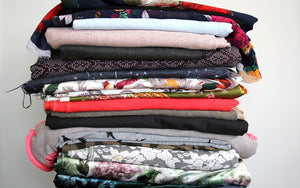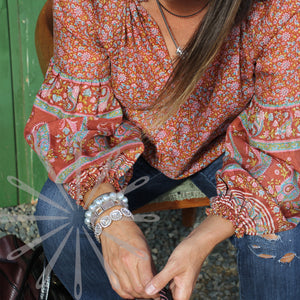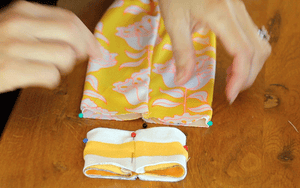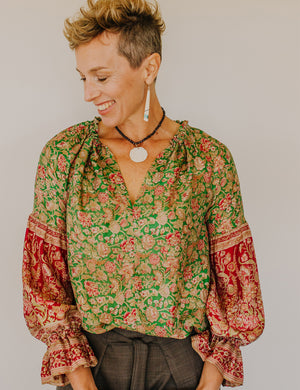Fabric recommendations - how important?
Choosing the right fabric has a major influence on the look and feel of your finished garment.
Getting this right comes with both experience or taking particular note of the recommended fabric clearly stated on all our pattern instructions.
We do our best to recommend fabrics for particular patterns in the aim of ensuring success - but sometimes people underestimate the importance of this. Who hasn't fallen in love with a piece of fabric (the colour or the print) and imagined it to look amazing sewn up in a particular garment - only to be disappointed in the end result. My guess is that you've chosen the wrong type of fabric (ie, one with the wrong drape or weight) for the garment style.
You are pretty safe if you follow our "recommended fabric" advice, but the following blog helps explain why fabric type (particulary drape and weight) affect the look and feel of a garment.
1. Fabric Drape:
Fabric drape refers to how a fabric hangs or falls when it is draped over a three-dimensional form, such as the human body. It is determined by the flexibility, stiffness, and fluidity of the fabric. A fabric with good drape flows smoothly and conforms to the curves and contours of the body, while a fabric with poor drape tends to hold its shape and may appear stiff or rigid.
Factors that influence fabric drape include the type of fibers used (fabric content), fabric construction methods, fabric finishing treatments, and the weight of the fabric.
Here are some examples of fabrics that typically exhibit good drape:
-
Silk (fabric content): Silk is woven thread from either a silk worm,
Most silk is renowned for its luxurious feel and excellent drape. It is lightweight, smooth, and has a natural sheen. Silk drapes beautifully, creating elegant and fluid lines. It is commonly used for dresses, blouses, scarves, and eveningwear. Note: some silk fabrics (like silk organza, dupioni or tussah silks) do not have good drape ** read more about silk here**
-
Rayon (fabric content): Rayon, often referred to as "artificial silk," is a semi-synthetic fabric made from cellulose fibers. It is lightweight, breathable, and has a soft and flowing drape. Rayon fabrics are versatile and are often used for various garments like dresses, skirts, blouses, and linings.

-
Chiffon (construction method): Chiffon is a lightweight, sheer fabric with a soft, delicate drape. It is commonly made from silk, polyester, or rayon fibers. Chiffon is known for its ethereal and floaty appearance, making it a popular choice for formal dresses, evening gowns, and scarves.
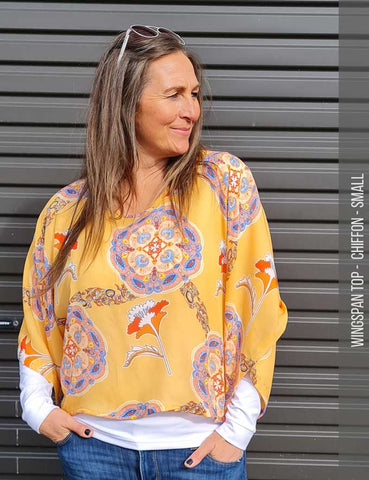
-
Georgette (construction method): Georgette is a lightweight, slightly crinkled fabric that has a good drape and a matte finish. It is usually made from silk or polyester. Georgette is commonly used for flowy dresses, blouses, skirts, and sarees.

Egret dress in poly viscose georgette -
Satin (construction method): Satin is a smooth, glossy fabric with a lustrous sheen. It can be made from silk, polyester, or a blend of fibers. Satin has a luxurious drape and is often used for evening gowns, lingerie, bridal wear, and formal attire.
-
Modal (fabric content): Modal is a semi-synthetic fabric made from beech tree pulp. It is known for its softness, breathability, and excellent drape. Modal fabrics have a silky feel and drape well, making them suitable for dresses, tops, and lightweight knitwear.
-
Lyocell/Tencel (fabric content): Lyocell, also known as Tencel, is an eco-friendly fabric made from wood pulp. It has a smooth, soft texture and offers good drape. Lyocell fabrics are used for a range of garments, including dresses, blouses, skirts, and trousers.

Hummingbird pants sewn in tencel
These fabrics are valued for their ability to enhance the aesthetics and comfort of garments, thanks to their excellent drape. However, it's important to note that variations within each fabric type exist, and factors like fabric thickness and finishing treatments also influence the drape.
On the other hand, fabrics with poor drape may create a more structured and stiff appearance. They might not conform to the body's shape as well and can result in a boxy or rigid look. These types of fabrics are often used for tailored suits, structured jackets, hats and bags or garments that require a more rigid shape.
Here are some examples of fabrics that have poor drape (are more stiff):
-
Denim (construction method and fibre thickness): Denim is a sturdy cotton fabric that is known for its durability and resistance to wear. It is tightly woven and has a stiff, firm feel. Denim is commonly used for jeans, jackets, and workwear where a structured and rugged look is desired.
-
Canvas (construction method and fibre thickness): Canvas is a heavy, durable fabric that is commonly made from cotton or linen. It has a plain weave and is tightly woven, resulting in a stiff and robust material. Canvas is often used for bags, tents, upholstery, and other items that require strength and stability.

-
Taffeta (construction method & finishing technique): Taffeta is a crisp and stiff fabric with a smooth, lustrous surface. It is usually made from silk or synthetic fibers. Taffeta's stiffness is due to its tight weave and the use of stiffening agents. It is commonly used for formal dresses, bridal gowns, and home decor items.
-
Brocade (construction method): Brocade is a decorative fabric characterized by its raised patterns and metallic threads. It is often made from silk or synthetic fibers. Brocade tends to be stiff due to its elaborate weave and the additional weight from the metallic threads. It is commonly used for formal wear, upholstery, and decorative accents.
-
Organza (construction method): While organza silk was mentioned earlier as a fabric with good drape, it can also be produced in a stiffer variant. Stiff organza has a crisp texture and minimal drape. It is commonly used for creating structured garments, ruffles, and overlays where a more voluminous or architectural look is desired.
-
Buckram (construction method & finishing technique): Buckram is a stiffened fabric often made from cotton or linen. It is heavily sized or starched to achieve a rigid and stiff quality. Buckram is commonly used in hat-making, bookbinding, and as a stiffening layer in garments where structure is required, such as collars or cuffs.
These fabrics are intentionally designed to have poor drape and stiffness for specific purposes such as durability, structure, or decorative effects. They are suitable for projects and garments where maintaining a particular shape or form is desired, rather than having the fabric flow and conform to the body.
2. Fabric Weight:
Fabric weight refers to the heaviness or lightness of a fabric, typically measured in grams per square meter (gsm) or ounces per square yard (oz/yd²). It is determined by the density of fibers or yarns in the fabric. A higher fabric weight indicates a denser or thicker fabric, while a lower fabric weight suggests a lighter and more breathable fabric (although breathability is also heavily influenced by fabric content as natural fibres are more breathable than synthetic fibres).
Fabric weight influences the comfort and functionality of a garment. Heavier fabrics provide more insulation and warmth, making them suitable for colder climates or winter garments. Lighter fabrics, on the other hand, are more breathable and ideal for warm weather or garments intended for active wear.
Heavier fabrics tend to have a more substantial and stable drape, which can be advantageous for garments that require structure or volume, such as coats or ball gowns.
Summary: Both fabric drape and fabric weight play a crucial role in the appearance and functionality of a finished garment.
Ultimately, the choice of fabric drape and weight depends on the desired style, functionality, and seasonality of the garment, as well as personal preference and the intended use of the finished product.

